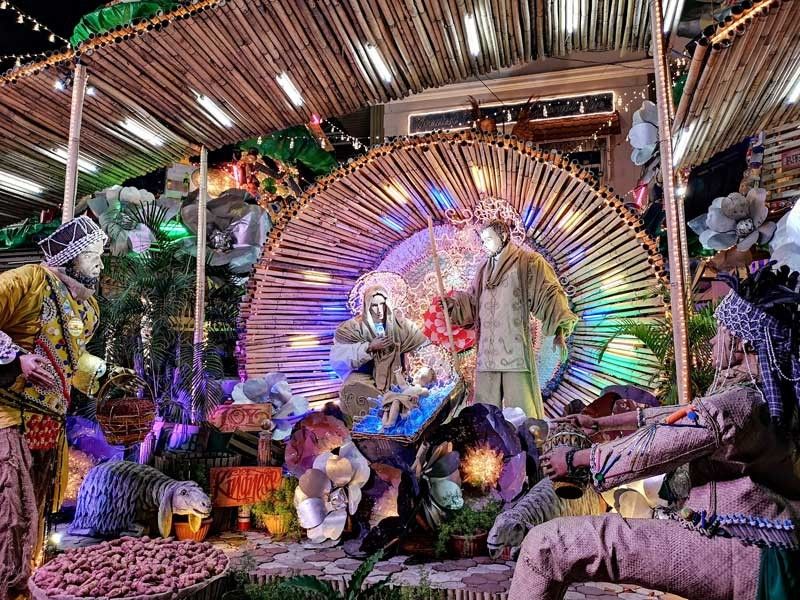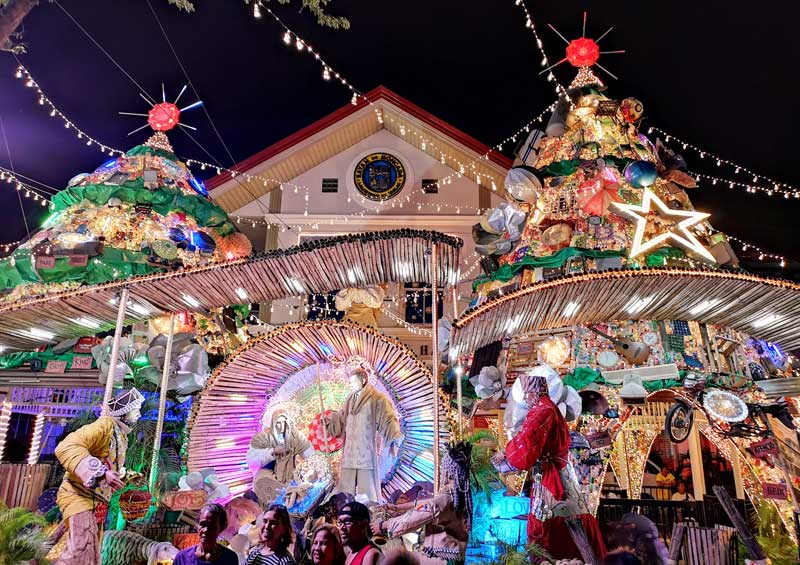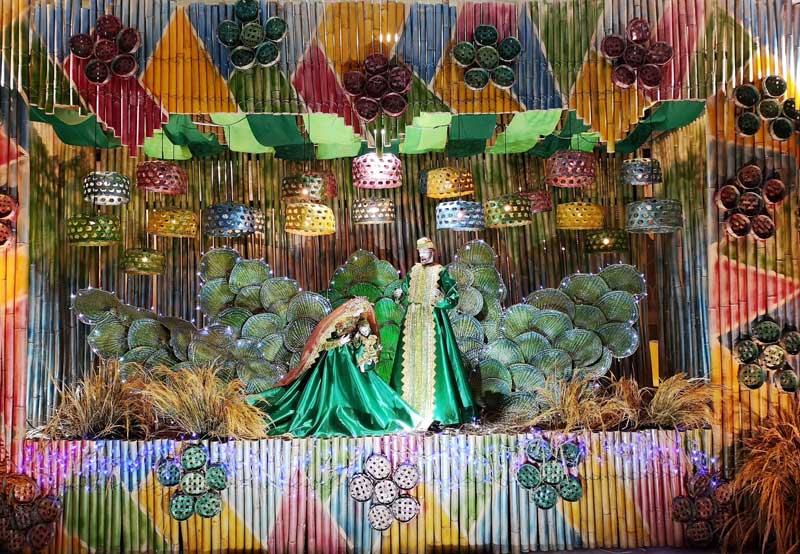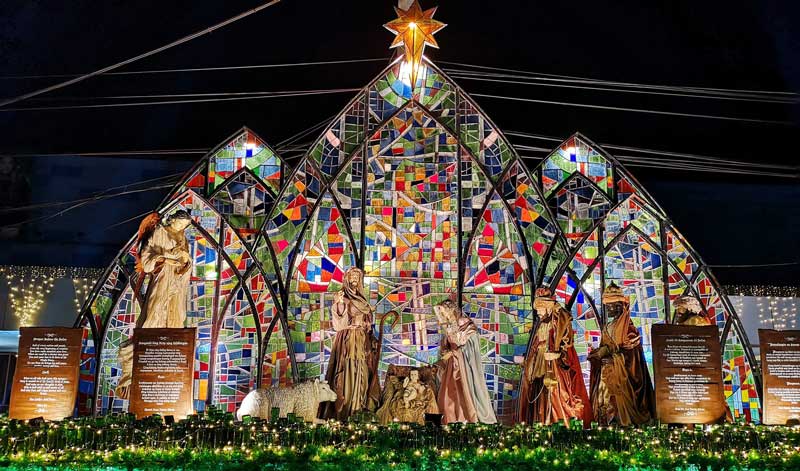Belenismo: A spectacle of hope



Inspired by a visit to the Holy Land where he’d been shown the traditional birthplace of Jesus, Saint Francis of Assisi, then a deacon, created the first nativity scene display at Greccio, in central Italy, in the 1200s. The exhibit, blessed by Pope Honorius III, was an attempt to place the emphasis of Christmas on the worship of Christ rather than secular materialism and gift giving.

Capas Municipality’s 13-meter tall Belen takes on Eiffel Tower as the backdrop for their winning Belen, made of bamboo, recycled materials and decorated with LED lights.
Saint Francis’ nativity scene, staged in a cave, was a living one with humans and animals cast in Biblical roles. It eventually grew to more elaborate affairs — humans and animals replaced with richly robed figurines against a backdrop of intricately decorated and landscaped static scenes.

McDonald’s Capas’ Belen features indigenous materials such as buho poles, native woven baskets and tinapa fish in various shades of green to represent environmental awareness.
Since then, the birth of Jesus has been depicted in various forms and continues to be interpreted in modern artistic forms around the world such as the Philippines’ famed Belenismo in the province of Tarlac.

Concepcion’s Belen made of papier-mache figures features the Holy Family with Joseph leading a carabao pulling a sled carrying Mary and baby Jesus. It reflects the history and tradition of the town — showing the migration of Kapampangans from neighboring Pampanga who brought along their carabao .
In 2007, the Belenismo or the “art of making Belen” was launched by the indefatigable mother-and-daughter tandem of Isabel Cojuangco Suntay and Dr. Isa Cojuangco Suntay, in Tarlac, under the auspices of the Tarlac Heritage Foundation. A simple vision to restore the religious and social significance of the Belen, it was christened “Belenismo sa Tarlac” and later earned the province the title “Belen-making capital of the Philippines.”

Made out of recycled materials from previous Belenismo events, the Philippine Army Belen takes on the monstrance as the inspiration for their award-winning creation this year.
Now in its 11th year, the spirit of Belenismo sa Tarlac 2018 is very much alive! It is a testament to the Tarlqueños’ resilience and inimitable, indomitable spirit by joining the competition notwithstanding economic challenges and the havoc brought about by typhoon Ompong in the province last September (as typhoon Lando did while preparing for the Belenismo in 2017).

Inspired by the livelihood of the women of Almaville Subdivision, their Belen uses materials and implements in bibingka-making such as bamboo and coconut shells.
As in the previous years, traditions of old bayanihan or communal unity is evident in the assemblage of masterfully crafted creches both large and small, depicting the humble birth of Jesus — the heart of Christmas. In keeping the spirit of Belenismo alive, Tarlqueños once again orchestrated this great event by showcasing their creativity, ingenuity and resourcefulness through their magnificent Belen creations using recycled indigenous and man-made materials from previous Belenismo events. This community undertaking transcends economic and social classes, political and religious choices.

San Francisco Shrine’s winning Belen is made out of bamboo and recycled plastic cups.
In this edition of Belenismo sa Tarlac, 26 belens in different categories (Grand Municipal, Grand Non-Municipal, Monumental, Church, and Community) made it to the finals out of a total of 55 entries from all over the province.

Nay’s House Belen features the Holy Family on a converted caroza decorated with flowers and leaves.
Winners in the Grand Municipality Category are: Capas, Moncada, and San Clemente (1st Prize), Victoria and Gerona (2nd Prize), Concepcion and San Manuel (3rd Prize).
In the Grand Non-Municipal Category, the Philippine Army Belen and SM Primeholdings Inc. Belen bagged the top award. Robinsons Land Corporation Belen and Tarelco Gerona Belen were 2nd and 3rd Prizes respectively.

SM Tarlac’s entry is a grand diorama with a backdrop of discarded stained glass from different churches in Luzon and a base recycled green plastic bottles.
Monumental Category winners are: McDonald’s Capas (1st Prize), Don Bosco Technical Institute and Nay’s House Restaurant (2nd Prize), Tarlac Agricultural University and Magic Star Mall (3rd Prize).

Noah’s Ark-inspired Belen of the San Lorenzo Ruiz Parish emerged as the grand winner in the Church Category of Belenismo 2018.
Church Category winners: San Lorenzo Ruiz Parish and San Roque Parish (1st Prize), San Francisco Shrine Anao (3rd Prize).
Community Category winners: Samahan sa Pura Community and Taguiporo Giants Association (1st Prize), McDonald’s Highway and Almaville Subdivision (2nd Prize), House of Cruz Belen and McDonald’s Motorway (3rd Prize).

Simple yet meaningful, the Samahan sa Pura Belen staged along a roadside creek bagged the grand prize in the Community Category.
The winners were announced in a ceremony last Dec. 1 at Robinsons Place in Tarlac City. Attending the awarding ceremonies were Defense Secretary Delfin Lorenzana (Guest of Honor), DOLE Secretary Silvestre H. Bello III, Interior Secretary Eduardo Manahan Año, Agrarian Reform Secretary John Rualo Castriciones, Energy Secretary Alfonso Cusi, National Security Adviser Hermogenes Esperon Jr., Cabinet Secretary Karlo Alexei Nograles, and Social Welfare Secretary Rolando Bautista.

Japanese-themed Belen of San Roque Parish emerged as co-grand winner in the Church Category with San Lorenzo Ruiz Parish.
The Belen is a familiar scene in Philippine Christmas that we see every year. But beyond the spectacle that delights the senses, the Belenismo actually stirs and revitalizes one’s spirituality. That’s why the Belenismo has remained so close to my heart and that of my fellow judges for the past 11 years.

Belenismo 2018 Judges: (from left) Cpt. Dexter Dantog, Maj. Frank Baylon, Roy Cobilla of Malaya, STAR lensman Rudy Santos, Isa Cojuangco Suntay of Tarlac Heritage Foundation, Ron Gagalac of ABS-CBN, PTV4’s Bea Bernardino, Mike Mina, Fr. Felipe Pardal, Yvonne Romualdez, the author, STAR columnist Michelle Soliven, Johnny Co, Doña Isabel Cojuangco Suntay, Jullie Yap Daza (Manila Bulletin), TV5’s Leila Chicadora, Gabriel Cardinoza (PDI), Cpt. Roderick Aday.
Tarlqueños for the past 11 years have been making room in their hearts for Jesus by way of their creches — their way of reminding others also to make room in their hearts for the coming of our dear Savior.
The Belenismo is a prayer. It is a bridge of hope between the sinful and God. The Belen is a symbol and a sign that we can achieve our hope for salvation and lasting peace.
* * *
Email me at miladay.star@gmail.com.















